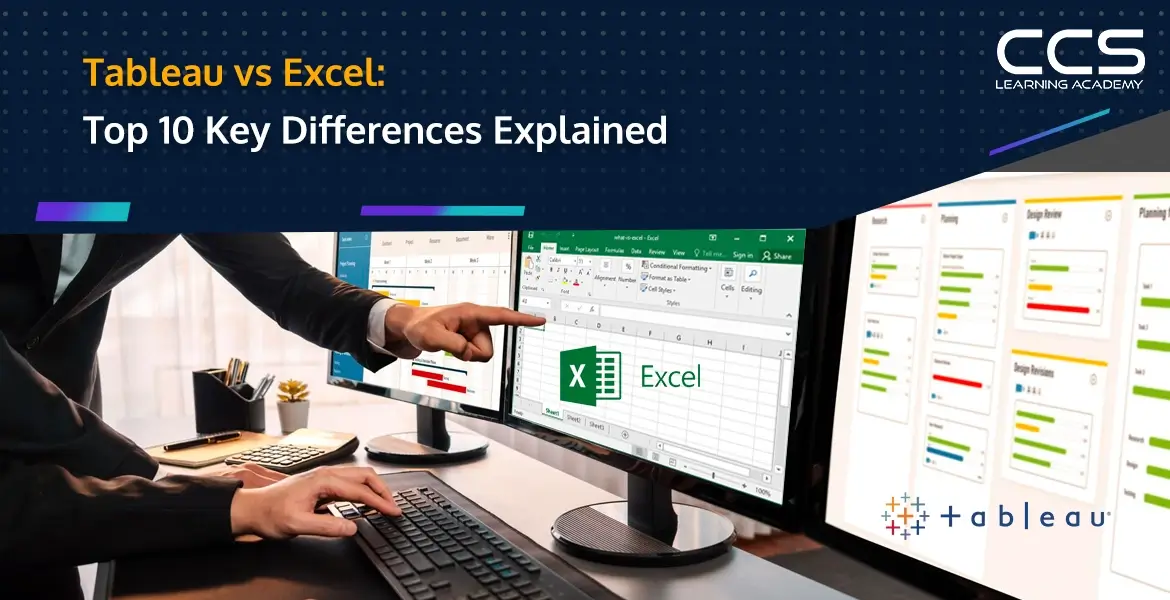Tableau vs. Excel: Top 10 Key Differences Explained
- -
- Time -

Tableau and Excel are both excellent software for data analysis. Both visualization tools help analysts bring perspective and insights into data. Querying and reporting become easy with them. Data analysts use them to analyze data, calculate analytics, and perform statistical operations. These tools are considered business intelligence and data visualization tools that identify hidden trends or patterns in data. These patterns are determined based on which insights are curated, and business executives use those insights to make impactful decisions for their operations.
However, it seems that both of these tools are similar. Each of them has unique features, advantages, and limitations. We are here with a comparative guide to highlight the major difference between Tableau vs. Excel. This will help you understand which software to use for your business.
What is Tableau?
Tableau is a business intelligence tool that allows you to connect, create, and visualize interactive and intriguing dashboards. Tableau is an excellent tool that helps data analysts visualize data right from the beginning of the process. With just a single click, you can get information and insights with the help of Tableau dashboards.
This tool lets you differentiate the data correlations using size, labels, shapes, and colors. This gives you context when exploring the data from a granular level. Furthermore, business intelligence software allows non-technical users to work on it in real time without requiring much knowledge. However, having good experience with the tool is necessary to operate it efficiently.
Benefits of Using Tableau
Compared to Tableau vs. Excel, Tableau has many advantages that help users obtain information and maximize efficiency.
Following are some major benefits of Tableau that you will find while using:
- Tableau’s dashboard includes an outstanding reporting feature. It facilitates the convenient customization of data.
- Tableau also offers dashboard features for mobile devices or laptops.
- Tableau allows the integration of technologies with its features.
- Tableau users can easily integrate Python or complex tools like R scripts to perform tasks.
- Tableau can handle a large amount of data at a time.
Limitations of Tableau
Some of the disadvantages of Tableau are as follows:
- It is helpful for only visualization and analysis. It cannot create query data.
- Tableau does not have automatic refreshing features for reports.
- Tableau’s conditional formatting option could be better, as it has a limited 16-column display.
However, if you wish to learn how to handle Tableau, you can join the CCSLA Analyze and Visualize Data using Tableau course.
What is Excel?
Microsoft Excel is a spreadsheet application that performs calculations, data analysis, reporting, and statistical operations. It consists of rows and columns, where users store data in the form of tables, charts, graphics, and other visualization methods.
Excel makes data informative and presentable according to their specific requirements. It can easily handle vast amounts of data and allows users to put conditional formatting and various different features to make the data meaningful and ready for the executives to go through for decision making.
How Does Excel Help Businesses?
On comparing Tableau vs. Excel, we see Excel has several advantages, which help users to operate efficiently. You can learn introductory to advanced concepts of Excel by easily subscribing to the Microsoft Office 365 Online (With Teams) course.
Some of the advantages that businesses get from using Excel are as follows:
- Microsoft Excel can quickly analyze large chunks of data, which makes it a better option for businesses.
- Microsoft Excel identified trends and patterns to help analysts derive conclusions.
- Excel can easily perform various mathematical and computational calculations, including all logical functions.
Limitations of Excel
Some of the limitations that you can find in Excel are as follows:
- It is challenging to troubleshoot.
- Sharing worksheets in Excel takes work, primarily online.
- Excel may be a better-fit option for agile business practices.
Tableau vs Excel: Comparison Table
There are various differences between Tableau and Excel. Based on their usage, security, interface, integrations, and several other aspects, we bring you ten significant differences between them.
| Parameters | Tableau | Excel |
| Definition | Tableau is a data visualization tool used for detailed analysis by data analysts to derive meaningful insights that business executives use to make effective decisions. | Excel is a spreadsheet application business analysts and modelers use to organize and format data. It allows data transformation by calculating and manipulating data using formulas. |
| Usage | Tableau can be a perfect fit for quick and easy data representation and visualization. | It is considered to be suitable for data storage and statistical analysis. |
| User interface | Tableau has a user-friendly interface that anyone can use without advanced knowledge of coding. | Excel has a very basic interface, which may not require prior knowledge, but experience should be there to work better on Excel while handling it. |
| Security | It has several options to keep data secure without scripting. Its advanced features enable anyone to get access to valuable data. | Excel has built-in security features, which may be weaker in Tableau. |
| Data sources | Tableau allows easy connection of data sources in real-time. | Excel needs plug-ins before integration with any non-excel sources. |
| Key highlights | Tableau has a quick and innovative visualization interface. It is an intuitive and powerful application that facilitates data joining, merging, and manipulation of big sets. | Excel is a descriptive tool that requires formulas to be entered for easy validation. It manipulates and interprets calculations to make calculation easy. |
| Benefits | Tableau is quick and interactive. It has appealing visualization techniques for big data. | Excel is a convenient data transformation tool. It manipulates descriptive statistics for better interpretation. |
| Performance | Tableau is an effective and efficient tool. It gives fast performance even when there is a large chunk of data. | Excel might function better when there is vast data. It requires little time to analyze the data and algorithms. But when analyzed, it performs at a high level with better accuracy. |
| Integration | Tableau offers integration features, meaning that any other applications can be integrated with Tableau to perform fast and facilitate multi-tasking. | Excel also offers integration features, but to a limited extent compared to Tableau. Excel can only be integrated with at most 60 applications. |
| Business purpose | Tableau provides analysis and visualization of data, which is then used by businesses to optimize their operations. | Excel is the most helpful application for businesses, as it allows them to generate quick reports and dashboards based on data. |
When to Use Tableau?
Tableau is used mainly in cases where visualization is needed or when exploring vast data sets. Furthermore, if you are a novice, you can learn Tableau with Tableau Desktop Level 1: Introduction for Novice Users course of CCSLA.
Here are some scenarios when businesses should use Tableau:
Exploratory data analysis
Tableau is best used to explore vast amounts of datasets and analyze them to uncover trends and patterns. It allows you to find outliers through effective visualization techniques.
Real-time analytics
When having a real-time analysis or deriving some immediate insights from live data sources, Tableau can be used crucially to give updated visualization and dynamic results.
Interactive dashboards and storytelling
Tableau is ideal for creating intuitive and creative dashboards with compelling data stories to facilitate better engagement and communication.
Collaborative analysis
If you collaborate with multiple users and simultaneously analyze or create a dashboard, Tableau can significantly help.
Executive presentation
You can use Tableau to create appealing visuals when showing or preparing reports for executives. Key performance indicators in Tableau can help executives understand data better.
Marketing and sales analytics
Understanding marketing and sales analytics becomes important. Tableau can help you analyze consumer data and behavior by transforming big data into actionable insights. This helps in better strategy formulation and decision-making.
When to Use Excel?
When understanding the differences of Tableau vs. Excel, you should know when to use these tools and when not. Excel is used for many simpler calculations and objectives. To understand Excel in advance, enrol in Microsoft Office Excel (2019-2016-2013): Advanced CCSLA course.
Following are some examples where Excel is an ideal option to use:
Small dataset analysis
Excel is best for handling small datasets requiring simple calculations and analysis with low complexity. Use Excel if you are working on simple projects with considerably less data.
Financial modeling
Financial modeling is a process of analyzing data to project future values and determine future trends based on historical data. To do so, you need a spreadsheet type of application for mining and accounting data. Preparing financial reports also requires extensive functions, which is best done in Excel.
Budgeting and planning
Budgeting and planning are both significantly crucial for any company. As an assisting tool, Excel will help analysts prepare the budget and plan future expenses and values.
Statistical analysis
Statistical analysis needs to run several tests and analyze more frequently. The statistical functions in Excel can help analysts to do so with ease.
Record keeping and data entry
If you want to keep records of consumers, employers, sales, or any other important database, you can create one for your business on Excel without issues. Excel has an easy interface, making data entry tasks easy, especially when the data volume is large.
Quick ad-hoc analysis
Excel can be the best option in situations requiring quick ad-hoc analysis or any immediate calculations. The accessibility and versatility of Excel make it a convenient option for users.
Tabular data interpretation
When having the primary need to organize data and keep the data in the proper format, you can use Excel. It enables analysts to create tables and arrange them through data validation and other techniques. With more structured lists and pivot tables, the Excel sheet keeps the data in a proper format.
What Does Your Business Need: Tableau vs. Excel?
When deciding which application to use for your business, you should first analyze its requirements. Understand why you need such tools for your business.
Is it to optimize efficiency or increase the operational capabilities of your business? Once you understand the requirements of such tools, compare Tableau vs. Excel, and then decide.
Your decision must be based on some of the necessary factors like:
- What type of report are you creating?
- What kind of data are you analyzing?
- Type of data you are working with
- How frequently do you need to create reports?
- The budget you have set
Conclusion
The comparison between Tableau and Excel underscores a major difference that allows businesses to choose the one that suits them best. Both data analysis tools emphasize dynamic visualization and interactive dashboards.
The intricate and vast datasets can easily be handled with these tools. Choosing between both these tools requires a purpose and objective that will define the suitability and requirement of such tools.
An analyst must have knowledge of such tools and know the difference between them to handle those applications well. If you want to learn and build your career in data science and data analytics, choose the CCSLA’s Data Analytics & Engineering Bootcamp bootcamp training program for one-to-one mentorship, hands-on project experience, and job placement assistance.
FAQs
Tableau is a powerful data visualization tool that allows users to create complex and interactive dashboards. It is designed to handle large datasets and facilitate deep data exploration, making it ideal for delivering actionable business insights through visualizations.
Excel is a spreadsheet application developed by Microsoft, widely used for data entry, complex calculations, data management, and simple to moderate data analysis. It provides versatile functionality for manipulating numeric data and performing various types of financial and statistical operations.
Tableau specializes in data visualization, offering advanced capabilities for creating interactive and dynamic visual reports that can handle large volumes of data. Excel, while capable of producing charts and graphs, is more limited in scope and interactivity, best suited for static and straightforward visualizations.
Tableau is better equipped to handle large datasets efficiently without performance lags. Excel has limitations in data capacity; it can become slow and less responsive when dealing with very large datasets or complex dynamic calculations.
Yes, Tableau and Excel can be integrated. Tableau can connect directly to Excel files to import data, allowing users to leverage Excel’s data calculation capabilities while utilizing Tableau’s advanced visualization and analytics tools.
The key strengths of Tableau compared to Excel include superior data visualization options, the ability to handle large amounts of data, and robust data integration capabilities with various databases and data formats. Tableau also offers more in-depth analytics and real-time data updates, which are crucial for timely decision-making.
Excel’s main advantages include its wide accessibility, familiarity among users, and versatility in performing a range of functions from data entry and budgeting to complex mathematical calculations. Excel is also more cost-effective for users who need a tool for basic data manipulation and visualization.
Tableau is the preferred choice for complex data visualization projects, large datasets, and scenarios where real-time data syncing is necessary. It is also better suited for creating interactive dashboards for business intelligence purposes.
Excel excels in scenarios requiring detailed numerical computations, such as financial modeling or when working with smaller datasets where advanced analytics is not required. It is also preferable for users who need a familiar interface for data manipulation and routine reporting.
Generally, Tableau is more expensive than Excel due to its specialized capabilities in data visualization and analytics. Excel is part of Microsoft Office, which provides a more cost-effective solution for users whose requirements are primarily spreadsheet-based operations and basic data analysis.






